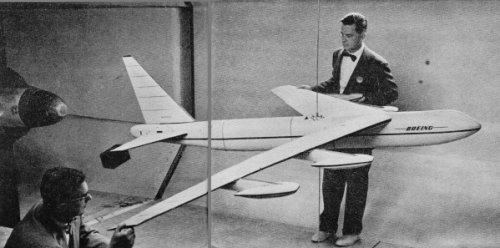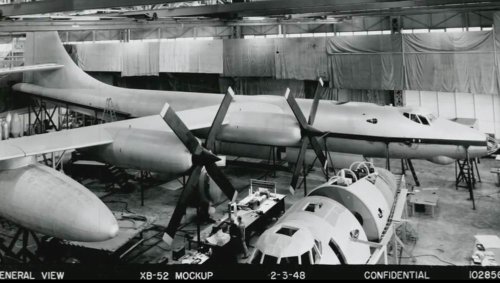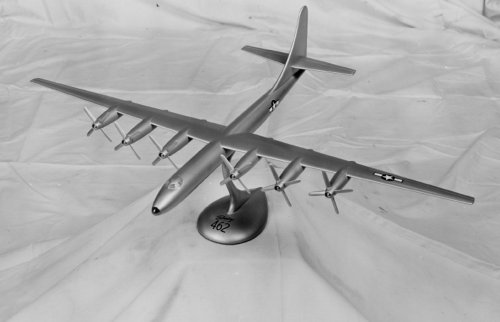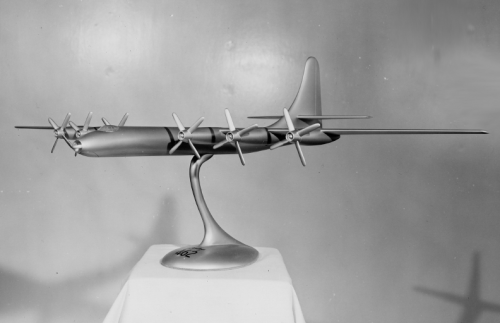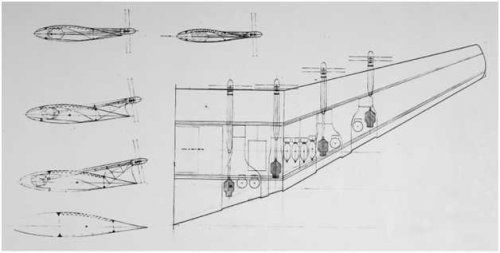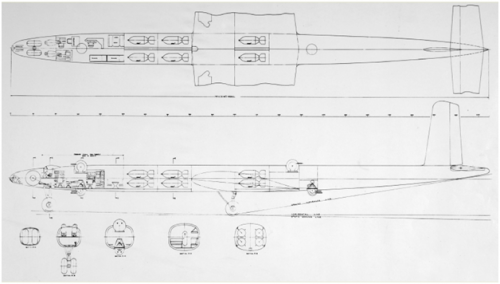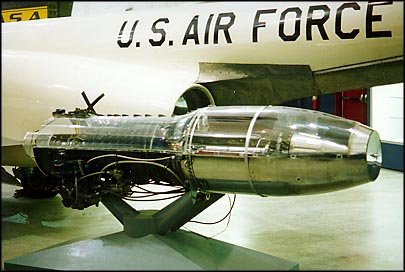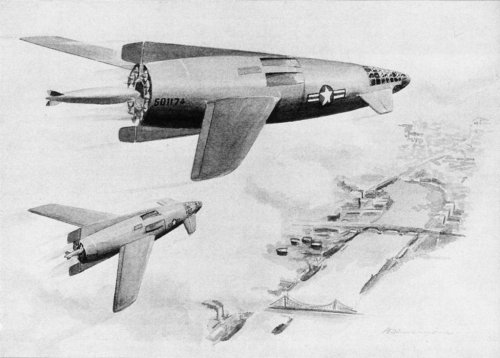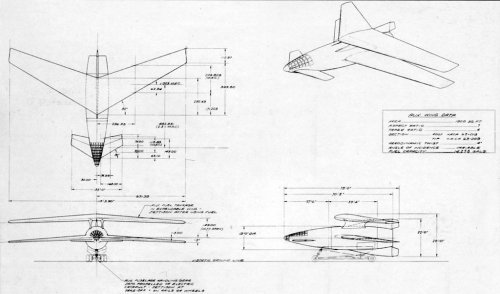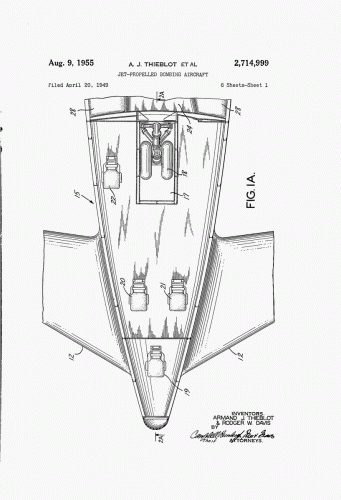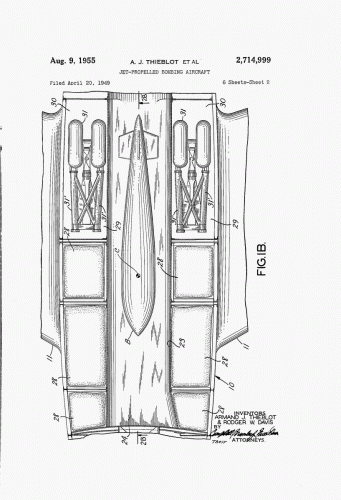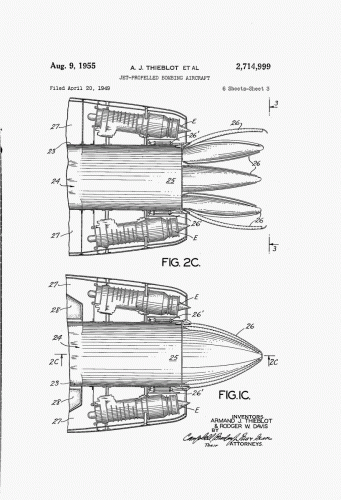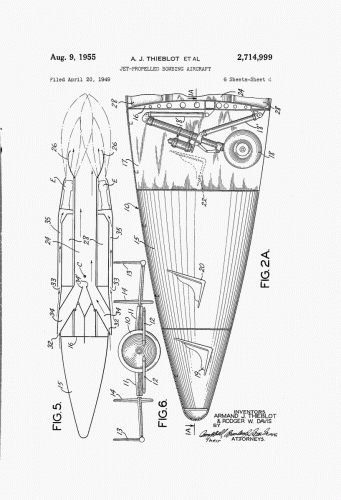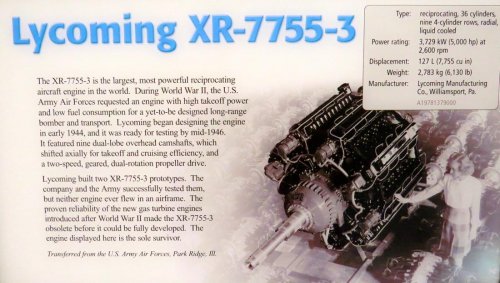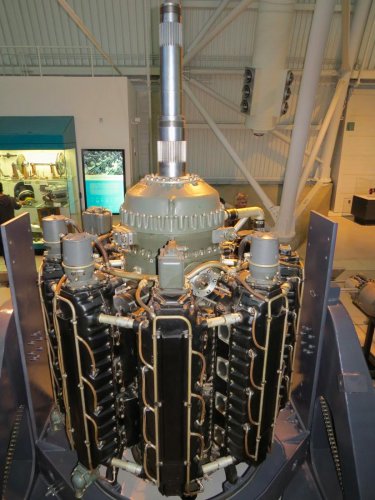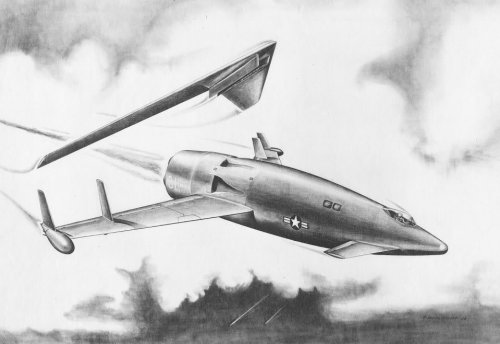How the B-52 emerged (Boeing and contending designs to the B-52)
- Thread starter devi
- Start date
- Joined
- 3 June 2006
- Messages
- 3,099
- Reaction score
- 3,996
B)
Here a video showing an early Boeing XB-52 mock-up (Model 464-17 or Model 464-29) with strait wings and turboprop engines.
Video:
https://youtu.be/f3F78ld-Lus?t=1m9s
I have never seen this mock-up before.
So maybe Flateric or someone else can take a clean screenshot and upload it to this topic.
Here a video showing an early Boeing XB-52 mock-up (Model 464-17 or Model 464-29) with strait wings and turboprop engines.
Video:
https://youtu.be/f3F78ld-Lus?t=1m9s
Code:
https://youtu.be/f3F78ld-Lus?t=1m9sI have never seen this mock-up before.
So maybe Flateric or someone else can take a clean screenshot and upload it to this topic.
Attachments
- Joined
- 1 April 2006
- Messages
- 11,421
- Reaction score
- 10,464
Model 464-35fightingirish said:So maybe Flateric or someone else can take a clean screenshot and upload it to this topic.
Attachments
-
![Weekend Warriors? Birth of the B-52.mp4_snapshot_01.06_[2015.12.01_02.50.19].jpg](/data/attachments/116/116066-9d828467cb80c150ea5c486a4825b642.jpg) Weekend Warriors? Birth of the B-52.mp4_snapshot_01.06_[2015.12.01_02.50.19].jpg160.1 KB · Views: 366
Weekend Warriors? Birth of the B-52.mp4_snapshot_01.06_[2015.12.01_02.50.19].jpg160.1 KB · Views: 366 -
![Weekend Warriors? Birth of the B-52.mp4_snapshot_01.08_[2015.12.01_02.46.39].jpg](/data/attachments/116/116065-299f3630e545e4975aa664d6a6f5bc3f.jpg) Weekend Warriors? Birth of the B-52.mp4_snapshot_01.08_[2015.12.01_02.46.39].jpg219.2 KB · Views: 305
Weekend Warriors? Birth of the B-52.mp4_snapshot_01.08_[2015.12.01_02.46.39].jpg219.2 KB · Views: 305 -
![Weekend Warriors? Birth of the B-52.mp4_snapshot_01.04_[2015.12.01_02.46.30].jpg](/data/attachments/116/116064-9f060a15e6e2bce98564b20dbc3795c1.jpg) Weekend Warriors? Birth of the B-52.mp4_snapshot_01.04_[2015.12.01_02.46.30].jpg161.6 KB · Views: 263
Weekend Warriors? Birth of the B-52.mp4_snapshot_01.04_[2015.12.01_02.46.30].jpg161.6 KB · Views: 263 -
![Weekend Warriors? Birth of the B-52.mp4_snapshot_01.03_[2015.12.01_02.46.25].jpg](/data/attachments/116/116063-78337cab573e1f34e367d15c59a8b71e.jpg) Weekend Warriors? Birth of the B-52.mp4_snapshot_01.03_[2015.12.01_02.46.25].jpg145.9 KB · Views: 222
Weekend Warriors? Birth of the B-52.mp4_snapshot_01.03_[2015.12.01_02.46.25].jpg145.9 KB · Views: 222 -
![Weekend Warriors? Birth of the B-52.mp4_snapshot_01.02_[2015.12.01_02.46.17].jpg](/data/attachments/116/116062-15e6a8f89157eae58460171103aa4750.jpg) Weekend Warriors? Birth of the B-52.mp4_snapshot_01.02_[2015.12.01_02.46.17].jpg136.4 KB · Views: 962
Weekend Warriors? Birth of the B-52.mp4_snapshot_01.02_[2015.12.01_02.46.17].jpg136.4 KB · Views: 962 -
![Weekend Warriors? Birth of the B-52.mp4_snapshot_01.01_[2015.12.01_02.46.07].jpg](/data/attachments/116/116061-24ab5cc92d615b5a793427a4ce8075e5.jpg) Weekend Warriors? Birth of the B-52.mp4_snapshot_01.01_[2015.12.01_02.46.07].jpg108.7 KB · Views: 1,046
Weekend Warriors? Birth of the B-52.mp4_snapshot_01.01_[2015.12.01_02.46.07].jpg108.7 KB · Views: 1,046
- Joined
- 22 January 2006
- Messages
- 4,230
- Reaction score
- 2,065
Great flateric. Never thought that early 464 iterations progressed so far into mockup stage. Thus I confused it with model 474. In my humble opinion, there is a family resemblance between this 464 sub-design and the 474 early turboprop designs.
Again, amateur researchers and aerospace fans are basically restricted to built aircraft and miss the bulk of the story which is made from those left in the drawing boards. Mockups are fascinating because is something in between. Great topic, thanks to the contributors.
Again, amateur researchers and aerospace fans are basically restricted to built aircraft and miss the bulk of the story which is made from those left in the drawing boards. Mockups are fascinating because is something in between. Great topic, thanks to the contributors.
- Joined
- 3 June 2006
- Messages
- 3,099
- Reaction score
- 3,996
Thanks to Jemiba and flateric for the screenshots! 
In the front right of this screenshot you see the two different cockpit configurations.

In the front right of this screenshot you see the two different cockpit configurations.
- Joined
- 22 January 2006
- Messages
- 4,230
- Reaction score
- 2,065
In the front right of this screenshot you see the two different cockpit configurations.
The tandem configuration is visible. What a lot of findings in a single photo!
Steve Pace
Aviation History Writer
- Joined
- 6 January 2013
- Messages
- 2,266
- Reaction score
- 226
Master carpenters at work using brads and glue instead of rivets! -SP
- Joined
- 17 October 2006
- Messages
- 2,393
- Reaction score
- 1,208
I'm not sure whether this question has been raised before here.
Two key events in bomber development took place very closely together: the conception and approval of the jet-boosted B-36D (design approved and demo authorized in Oct 1948) and the AF's legendary "thanks but no thanks" to a turboprop XB-52 (Oct 21 1948).
Has anyone published or found primary-source documents that establish a causal link between the two? I know that B-36 histories suggest that after the AF/AAF turned down the B-36C, the Convair bomber's days seemed numbered until the idea of jet boost was adopted. Clearly, too, if the advantage of the turboprop XB-52 was speed and altitude over a defended area, the jet-boosted B-36D eroded it.
Lori Tagg's monograph* quotes the AF's Col Henry Warden: "Colonel Warden told the three men that the B-52 was not a significant enough improvement over the B-36 for the Air Force to justify further development." But at that point, is Warden talking about the new jet-boosted version?
It's a fascinating historical question, because it places a lot of credit for the genesis of today's B-52 on whoever looked at a B-47's engine pods and said "hey, what if..?"
*http://www.amazon.com/Development-B-52-Wright-Field-Story/dp/B000NM0YB0
Two key events in bomber development took place very closely together: the conception and approval of the jet-boosted B-36D (design approved and demo authorized in Oct 1948) and the AF's legendary "thanks but no thanks" to a turboprop XB-52 (Oct 21 1948).
Has anyone published or found primary-source documents that establish a causal link between the two? I know that B-36 histories suggest that after the AF/AAF turned down the B-36C, the Convair bomber's days seemed numbered until the idea of jet boost was adopted. Clearly, too, if the advantage of the turboprop XB-52 was speed and altitude over a defended area, the jet-boosted B-36D eroded it.
Lori Tagg's monograph* quotes the AF's Col Henry Warden: "Colonel Warden told the three men that the B-52 was not a significant enough improvement over the B-36 for the Air Force to justify further development." But at that point, is Warden talking about the new jet-boosted version?
It's a fascinating historical question, because it places a lot of credit for the genesis of today's B-52 on whoever looked at a B-47's engine pods and said "hey, what if..?"
*http://www.amazon.com/Development-B-52-Wright-Field-Story/dp/B000NM0YB0
blackkite
Don't laugh, don't cry, don't even curse, but.....
- Joined
- 31 May 2007
- Messages
- 8,826
- Reaction score
- 7,756
blackkite
Don't laugh, don't cry, don't even curse, but.....
- Joined
- 31 May 2007
- Messages
- 8,826
- Reaction score
- 7,756
Re: How the B-52 emerged (Boeing and contending designs to the B-52)
Hi!
http://youroker.livejournal.com/36573.html
"The sources of the B-52 go into the distant military 1944 - on August 15, the technical office in Wright Field recommended starting the development of the project of a jet / turboprop heavy bomber. It was supposed that in 1946 a competition for the best project will be held, and in the interval between 1947 and 1949 the first prototype will be built. The development of the aircraft allocated 650,000 dollars, the very construction of the aircraft was estimated at 16 million dollars. On assignment, the bomber was intended to replace the Convair XB-36, which had been under construction since 1941. By 1944, the command of the US Air Force began to realize that the XB-36 could not survive in the conditions of combat with jet aircraft, which means it was already obsolete. In April 1945, Boeing was asked to develop a project based on the XB-36, but with new turboprop engines. The Boeing refused, explaining its refusal by the fact that the very design of the XB-36 does not meet modern requirements (citation: "so completely out of line with the state of the art").
On November 23, 1945, the final requirements for a new bomber were ready. The aircraft required high speed and range, flight at high altitude, takeoff from ground airfields.In February 1946 technical requirements were clarified, they introduced a mandatory requirement for installation of turbojet engines on the aircraft. Also, the requirements for range were reduced, since they were unattainable at that level of technology development when using turboprop engines.
By mid-1946 drafts of bombers from Boeing, Convair and Martin were prepared. All three did not fully meet the given criteria, so no project provided take-off from the ground airfields, but all were admitted to the competition.
June 27, 1946 in Boeing presented their vision of a prospective heavy bomber. According to the description, the aircraft concentrated all the achievements of engineering, especially electronics. Boeing engineers claimed that the design of the aircraft took into account all the shortcomings of the XB-36. As it was written in the project brochure, it was "... the most advanced aircraft out of those that can be created at this level of technology development." The project itself was called Model 462.
When creating the aircraft, first of all the engineers focused on achieving the speed and range parameters specified in the technical task, the wing profile and placement of the nacelle engines were optimized for these requirements. Of all the submitted projects, 462 was the largest and could provide the longest flight range with the greatest bomb load. It was also possible to install and suspend fuel tanks, which further increased the range. "
"In late August 1946 , all data on the Model 462 were transferred to the newly created corporation RAND (Research and Development) to study and make recommendations . In early September 1946 the year RAND rendered its verdict . According to engineers RAND Model 462 is an outdated concept of a bomber , the aircraft was extremely peretyazhel . Its huge size ( I will remind , that the Model 462 was greater in - 36) not only did not give easily increase the flight range , but even reduced it . According to experts RAND was required to reduce the plane of at least one and a half times . Also recommended to reconsider the concept of defensive weapons and inefficient huge tail of the aircraft . This report was submitted to the Aeronautical Commission , who in turn passed the report of Boeing, where he caused a very negative reaction . According to engineers Boeing report was drafted amateurishly and bore in itself only harm . Reducing the bomber would make it slower , less altitude and hoisting , would reduce its protective properties . Unknown , guided by whether engineers Boeing interests of the company , desiring to put on the conveyor more large and expensive aircraft , or simply mistaken . But fortunately the military supported the view RAND. In October 1946 the year Boeing received the task to reduce the aircraft .
To this end the story of the first competition XB - 52, but does not end the story XB - 52. "
Hi!
http://youroker.livejournal.com/36573.html
"The sources of the B-52 go into the distant military 1944 - on August 15, the technical office in Wright Field recommended starting the development of the project of a jet / turboprop heavy bomber. It was supposed that in 1946 a competition for the best project will be held, and in the interval between 1947 and 1949 the first prototype will be built. The development of the aircraft allocated 650,000 dollars, the very construction of the aircraft was estimated at 16 million dollars. On assignment, the bomber was intended to replace the Convair XB-36, which had been under construction since 1941. By 1944, the command of the US Air Force began to realize that the XB-36 could not survive in the conditions of combat with jet aircraft, which means it was already obsolete. In April 1945, Boeing was asked to develop a project based on the XB-36, but with new turboprop engines. The Boeing refused, explaining its refusal by the fact that the very design of the XB-36 does not meet modern requirements (citation: "so completely out of line with the state of the art").
On November 23, 1945, the final requirements for a new bomber were ready. The aircraft required high speed and range, flight at high altitude, takeoff from ground airfields.In February 1946 technical requirements were clarified, they introduced a mandatory requirement for installation of turbojet engines on the aircraft. Also, the requirements for range were reduced, since they were unattainable at that level of technology development when using turboprop engines.
By mid-1946 drafts of bombers from Boeing, Convair and Martin were prepared. All three did not fully meet the given criteria, so no project provided take-off from the ground airfields, but all were admitted to the competition.
June 27, 1946 in Boeing presented their vision of a prospective heavy bomber. According to the description, the aircraft concentrated all the achievements of engineering, especially electronics. Boeing engineers claimed that the design of the aircraft took into account all the shortcomings of the XB-36. As it was written in the project brochure, it was "... the most advanced aircraft out of those that can be created at this level of technology development." The project itself was called Model 462.
When creating the aircraft, first of all the engineers focused on achieving the speed and range parameters specified in the technical task, the wing profile and placement of the nacelle engines were optimized for these requirements. Of all the submitted projects, 462 was the largest and could provide the longest flight range with the greatest bomb load. It was also possible to install and suspend fuel tanks, which further increased the range. "
"In late August 1946 , all data on the Model 462 were transferred to the newly created corporation RAND (Research and Development) to study and make recommendations . In early September 1946 the year RAND rendered its verdict . According to engineers RAND Model 462 is an outdated concept of a bomber , the aircraft was extremely peretyazhel . Its huge size ( I will remind , that the Model 462 was greater in - 36) not only did not give easily increase the flight range , but even reduced it . According to experts RAND was required to reduce the plane of at least one and a half times . Also recommended to reconsider the concept of defensive weapons and inefficient huge tail of the aircraft . This report was submitted to the Aeronautical Commission , who in turn passed the report of Boeing, where he caused a very negative reaction . According to engineers Boeing report was drafted amateurishly and bore in itself only harm . Reducing the bomber would make it slower , less altitude and hoisting , would reduce its protective properties . Unknown , guided by whether engineers Boeing interests of the company , desiring to put on the conveyor more large and expensive aircraft , or simply mistaken . But fortunately the military supported the view RAND. In October 1946 the year Boeing received the task to reduce the aircraft .
To this end the story of the first competition XB - 52, but does not end the story XB - 52. "
Attachments
-
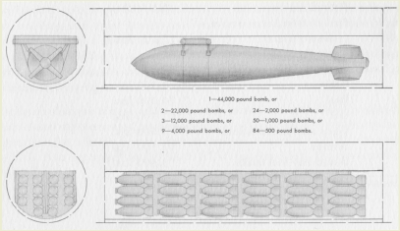 The option of placing the bomb load.png73.1 KB · Views: 146
The option of placing the bomb load.png73.1 KB · Views: 146 -
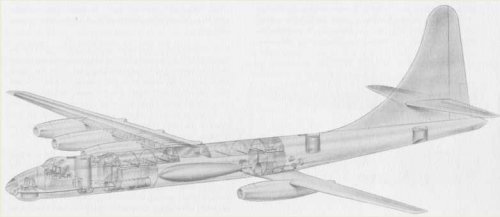 Boeing Model 462 is a sectional view. In the bomb bay you can see a 20 ton T12 bomb.jpg12 KB · Views: 146
Boeing Model 462 is a sectional view. In the bomb bay you can see a 20 ton T12 bomb.jpg12 KB · Views: 146 -
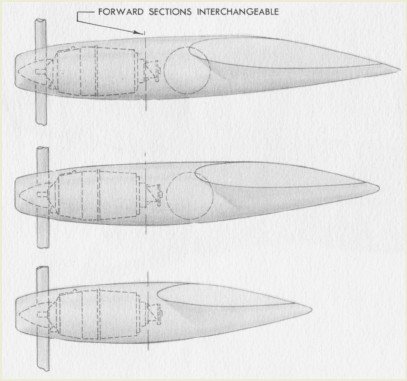 Side view of the Model 462 nacelle.jpg28.2 KB · Views: 151
Side view of the Model 462 nacelle.jpg28.2 KB · Views: 151 -
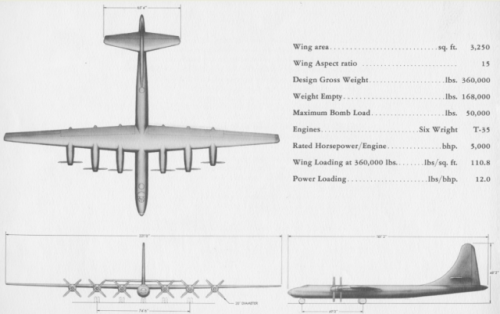 462 specification.png184.2 KB · Views: 151
462 specification.png184.2 KB · Views: 151 -
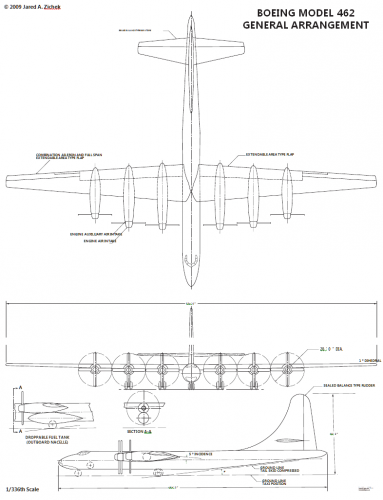 Drawing Model 462. It is evident involves placing external fuel tanks ..png99.4 KB · Views: 152
Drawing Model 462. It is evident involves placing external fuel tanks ..png99.4 KB · Views: 152 -
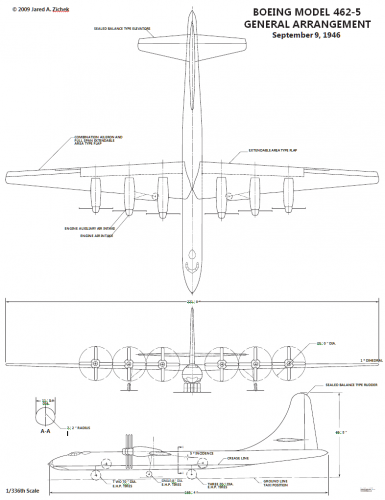 Drawing Model 462 5.png131 KB · Views: 159
Drawing Model 462 5.png131 KB · Views: 159 -
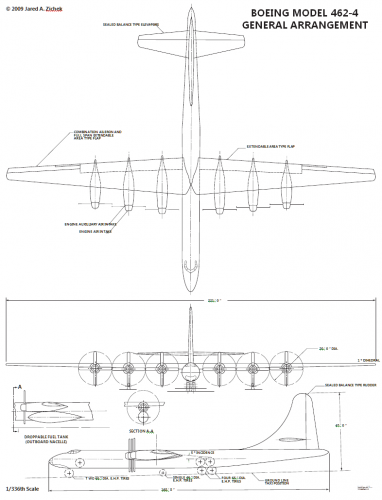 Drawing Model 462 4.png139 KB · Views: 168
Drawing Model 462 4.png139 KB · Views: 168 -
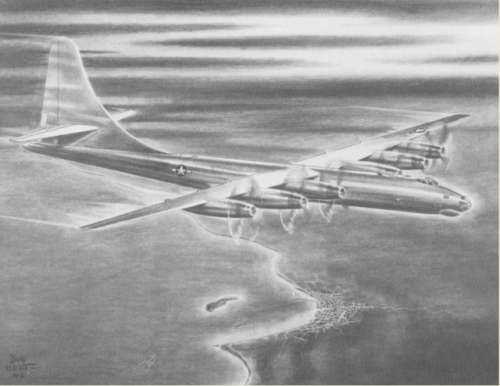 Modified Model 462.png269.4 KB · Views: 166
Modified Model 462.png269.4 KB · Views: 166 -
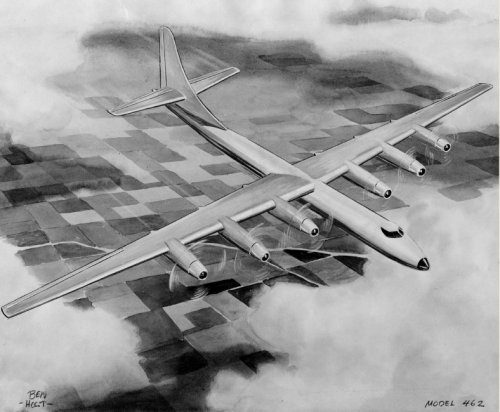 Model 462.jpg121.9 KB · Views: 167
Model 462.jpg121.9 KB · Views: 167
blackkite
Don't laugh, don't cry, don't even curse, but.....
- Joined
- 31 May 2007
- Messages
- 8,826
- Reaction score
- 7,756
blackkite
Don't laugh, don't cry, don't even curse, but.....
- Joined
- 31 May 2007
- Messages
- 8,826
- Reaction score
- 7,756
Re: How the B-52 emerged (Boeing and contending designs to the B-52)
Hi! Convair designed LRHBA, competitor of 462. It was a mix powered bomber.
"In the summer of 1946, Convair offered his variant of a long-range bomber. The project was named very simply: Consolidated Vultee Long Range Heavy Bombardment Airplane (we will use the LRHBA shortcut later), which translates to the Far Heavy Bomber from Consolidated Vultee. The main distinguishing feature of this aircraft was a wing with a reverse sweep. The project itself was the development of ideas laid down in the HA-44, developed by Convair in 1945 for a heavy support / tactical bomber competition. It was from him that many decisions were taken, including the wing of reverse sweep.
In the description attached to the project, it was reported that Convair intentionally did not fulfill in its draft technical requirements for a prospective strategic bomber, since he considers these requirements unattainable at this level of technology development. Therefore, the proposed project is a transitional machine, performed at the maximum development of modern technology, which later can be brought to the level set in the requirements. There is a possibility that Convair deliberately focused on the impossibility of meeting the requirements, in the hope of closing the project potentially dangerous for its B-36, but it is impossible to confirm this. "
Hi! Convair designed LRHBA, competitor of 462. It was a mix powered bomber.
"In the summer of 1946, Convair offered his variant of a long-range bomber. The project was named very simply: Consolidated Vultee Long Range Heavy Bombardment Airplane (we will use the LRHBA shortcut later), which translates to the Far Heavy Bomber from Consolidated Vultee. The main distinguishing feature of this aircraft was a wing with a reverse sweep. The project itself was the development of ideas laid down in the HA-44, developed by Convair in 1945 for a heavy support / tactical bomber competition. It was from him that many decisions were taken, including the wing of reverse sweep.
In the description attached to the project, it was reported that Convair intentionally did not fulfill in its draft technical requirements for a prospective strategic bomber, since he considers these requirements unattainable at this level of technology development. Therefore, the proposed project is a transitional machine, performed at the maximum development of modern technology, which later can be brought to the level set in the requirements. There is a possibility that Convair deliberately focused on the impossibility of meeting the requirements, in the hope of closing the project potentially dangerous for its B-36, but it is impossible to confirm this. "
Attachments
-
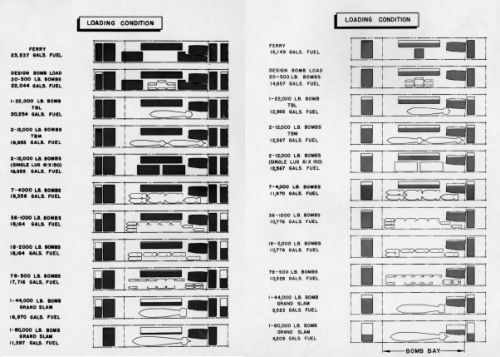 Variants of the bomb load of the aircraft.png247.8 KB · Views: 133
Variants of the bomb load of the aircraft.png247.8 KB · Views: 133 -
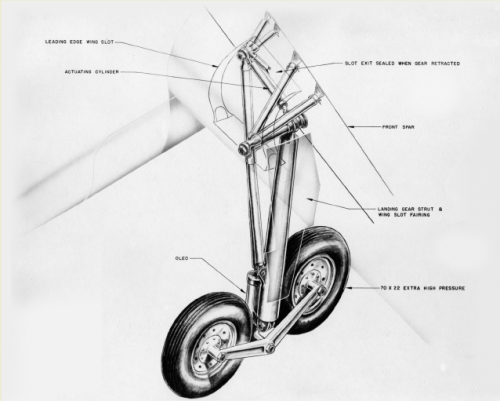 Wing rack chassis Convair LRHBA..png258.4 KB · Views: 125
Wing rack chassis Convair LRHBA..png258.4 KB · Views: 125 -
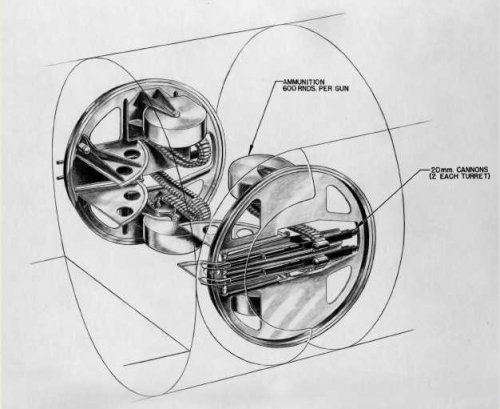 The construction of defensive turrets..jpg29.9 KB · Views: 131
The construction of defensive turrets..jpg29.9 KB · Views: 131 -
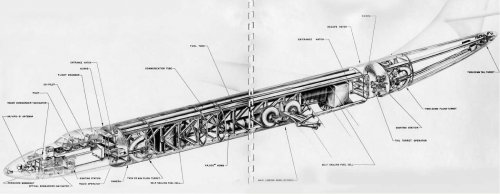 Convair LRHB scheme. Defensive turrets and a retracted landing gear are clearly visible.jpg75.2 KB · Views: 146
Convair LRHB scheme. Defensive turrets and a retracted landing gear are clearly visible.jpg75.2 KB · Views: 146 -
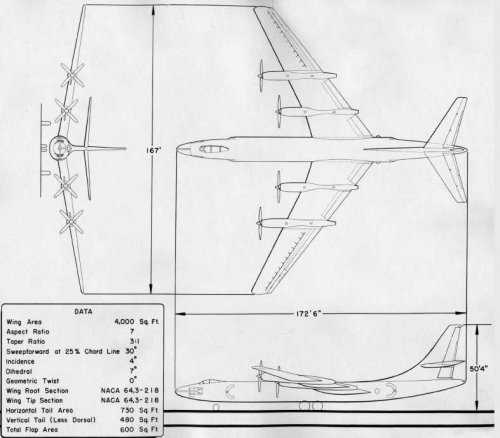 General scheme and basic characteristics of the Convair LRHBA wing..jpg39.7 KB · Views: 143
General scheme and basic characteristics of the Convair LRHBA wing..jpg39.7 KB · Views: 143 -
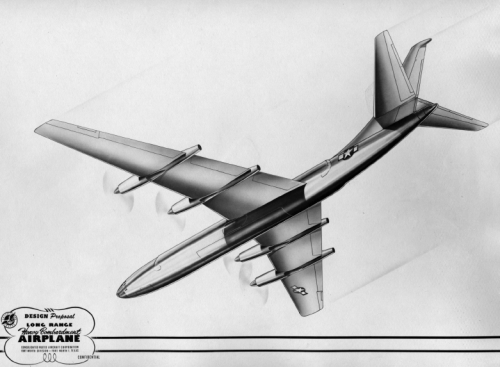 Convair LRHBA, rear view..png355.3 KB · Views: 142
Convair LRHBA, rear view..png355.3 KB · Views: 142 -
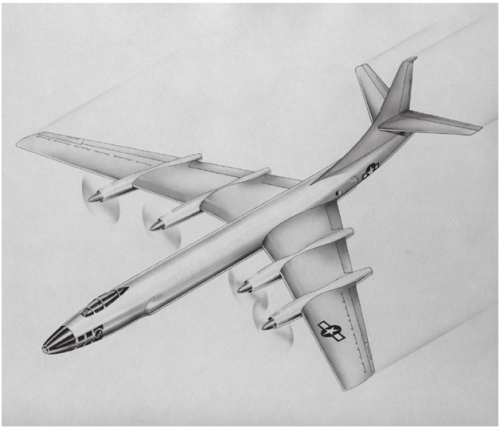 Consolidated Vultee Long Range Heavy Bombardment Airplane..png300.4 KB · Views: 156
Consolidated Vultee Long Range Heavy Bombardment Airplane..png300.4 KB · Views: 156
blackkite
Don't laugh, don't cry, don't even curse, but.....
- Joined
- 31 May 2007
- Messages
- 8,826
- Reaction score
- 7,756
Re: How the B-52 emerged (Boeing and contending designs to the B-52)
Martin competitor 236 flying wing bomber and 236-2 bomber.
"The last to be submitted was a draft bomber from Martin. The aircraft was made according to the traditional scheme, but it had several interesting solutions in the design. According to the project it was a mid-wing with a wingspan of 60 meters, weighing 125 tons, with a working ceiling of 10 kilometers and a practical one of 13 kilometers. As in previous projects, all the requirements were not met, so the range (at a load of 4.5 tons) was only 3,500 kilometers, the speed of only 700 kilometers per hour at an altitude of 5 and a half kilometers. The aircraft received the designation Martin Model 236.
A distinctive feature of the aircraft was an attempt to combine the pluses of the standard design and the "flying wing". From conventional aircraft, the Model 236 received a standard aircraft fuselage, from the "flying wings" - a wing with a very thick aerodynamic profile. In the wing, eight pushing piston or turboprop engines were completely housed, not protruding beyond the profile of the wing profile. The aircraft was supposed to use either turbo-screw engines Wright T-35 or reciprocating engines Lycoming R-7755 with a capacity of 5000 horsepower each. Also in the wing were placed two small bomb bays at 5 tons each, between the second and third and between the sixth and seventh engines. In addition, the variant of the aircraft with the usual layout and wing, which was called the Martin Model 236-2, was worked out.
The tail plumage was carried out according to the traditional scheme, without any hint of a sweep. At design speeds, such a feathering would be extremely inefficient, and we can assume that it will be replaced with a more suitable one. Defensive weapons consisted of 4 spherical turrets half-submerged in a hull. Equipping turrets - 20 mm guns. The construction of turrets can also be considered unsuccessful, since they seriously affected the speed of the aircraft. The bomb load was 18 tons: 5 tons in two wing bombs and 8 tons in the fuselage for the Martin Model 236-2 or two bomb bays in the fuselage for the Martin Model 236-2."
Martin competitor 236 flying wing bomber and 236-2 bomber.
"The last to be submitted was a draft bomber from Martin. The aircraft was made according to the traditional scheme, but it had several interesting solutions in the design. According to the project it was a mid-wing with a wingspan of 60 meters, weighing 125 tons, with a working ceiling of 10 kilometers and a practical one of 13 kilometers. As in previous projects, all the requirements were not met, so the range (at a load of 4.5 tons) was only 3,500 kilometers, the speed of only 700 kilometers per hour at an altitude of 5 and a half kilometers. The aircraft received the designation Martin Model 236.
A distinctive feature of the aircraft was an attempt to combine the pluses of the standard design and the "flying wing". From conventional aircraft, the Model 236 received a standard aircraft fuselage, from the "flying wings" - a wing with a very thick aerodynamic profile. In the wing, eight pushing piston or turboprop engines were completely housed, not protruding beyond the profile of the wing profile. The aircraft was supposed to use either turbo-screw engines Wright T-35 or reciprocating engines Lycoming R-7755 with a capacity of 5000 horsepower each. Also in the wing were placed two small bomb bays at 5 tons each, between the second and third and between the sixth and seventh engines. In addition, the variant of the aircraft with the usual layout and wing, which was called the Martin Model 236-2, was worked out.
The tail plumage was carried out according to the traditional scheme, without any hint of a sweep. At design speeds, such a feathering would be extremely inefficient, and we can assume that it will be replaced with a more suitable one. Defensive weapons consisted of 4 spherical turrets half-submerged in a hull. Equipping turrets - 20 mm guns. The construction of turrets can also be considered unsuccessful, since they seriously affected the speed of the aircraft. The bomb load was 18 tons: 5 tons in two wing bombs and 8 tons in the fuselage for the Martin Model 236-2 or two bomb bays in the fuselage for the Martin Model 236-2."
Attachments
blackkite
Don't laugh, don't cry, don't even curse, but.....
- Joined
- 31 May 2007
- Messages
- 8,826
- Reaction score
- 7,756
Re: How the B-52 emerged (Boeing and contending designs to the B-52)
Is this post wrong? I only want to understand what happened and I only want to know the truth.
http://youroker.livejournal.com/36573.html
Is this post wrong? I only want to understand what happened and I only want to know the truth.
http://youroker.livejournal.com/36573.html
XP67_Moonbat
ACCESS: Top Secret
- Joined
- 16 January 2008
- Messages
- 2,273
- Reaction score
- 550
Re: How the B-52 emerged (Boeing and contending designs to the B-52)
Blackkite, did you Flateric? You need to stop, dude.
Blackkite, did you Flateric? You need to stop, dude.
- Joined
- 29 September 2006
- Messages
- 1,799
- Reaction score
- 1,368
I think the latest links uploaded by Blackkite were put on the web by Jared himself, so I don't think they can be seen as a violation of forum policy.
blackkite
Don't laugh, don't cry, don't even curse, but.....
- Joined
- 31 May 2007
- Messages
- 8,826
- Reaction score
- 7,756
Me,too.starviking said:I think the latest links uploaded by Blackkite were put on the web by Jared himself, so I don't think they can be seen as a violation of forum policy.
- Joined
- 1 April 2006
- Messages
- 11,421
- Reaction score
- 10,464
Exactly. Apart from deleted.starviking said:I think the latest links uploaded by Blackkite were put on the web by Jared himself, so I don't think they can be seen as a violation of forum policy.
blackkite
Don't laugh, don't cry, don't even curse, but.....
- Joined
- 31 May 2007
- Messages
- 8,826
- Reaction score
- 7,756
Hi! More Fairchild M-121. I can see jettisonable wing shape fuel tank over the fuselage.
http://blog.livedoor.jp/janome_gotyou/archives/2015-02.html
http://blog.livedoor.jp/janome_gotyou/archives/2015-02.html
Attachments
blackkite
Don't laugh, don't cry, don't even curse, but.....
- Joined
- 31 May 2007
- Messages
- 8,826
- Reaction score
- 7,756
archipeppe
ACCESS: Top Secret
- Joined
- 18 October 2007
- Messages
- 2,437
- Reaction score
- 3,182
Pure science fiction thanks Blakkite!
blackkite
Don't laugh, don't cry, don't even curse, but.....
- Joined
- 31 May 2007
- Messages
- 8,826
- Reaction score
- 7,756
Oh!!archipeppe said:Pure science fiction thanks Blakkite!
- Joined
- 29 September 2006
- Messages
- 1,799
- Reaction score
- 1,368
blackkite said:Oh!!archipeppe said:Pure science fiction thanks Blakkite!Why do you think so? Jettisonable fuel tank? Bombing method was same as A-5. ;D
It looks a little like a "Flash Gordon" spaceship.
- Joined
- 27 December 2005
- Messages
- 17,790
- Reaction score
- 26,897
LowObservable said:I'm not sure whether this question has been raised before here.
Two key events in bomber development took place very closely together: the conception and approval of the jet-boosted B-36D (design approved and demo authorized in Oct 1948) and the AF's legendary "thanks but no thanks" to a turboprop XB-52 (Oct 21 1948).
Has anyone published or found primary-source documents that establish a causal link between the two? I know that B-36 histories suggest that after the AF/AAF turned down the B-36C, the Convair bomber's days seemed numbered until the idea of jet boost was adopted. Clearly, too, if the advantage of the turboprop XB-52 was speed and altitude over a defended area, the jet-boosted B-36D eroded it.
Lori Tagg's monograph* quotes the AF's Col Henry Warden: "Colonel Warden told the three men that the B-52 was not a significant enough improvement over the B-36 for the Air Force to justify further development." But at that point, is Warden talking about the new jet-boosted version?
It's a fascinating historical question, because it places a lot of credit for the genesis of today's B-52 on whoever looked at a B-47's engine pods and said "hey, what if..?"
*http://www.amazon.com/Development-B-52-Wright-Field-Story/dp/B000NM0YB0
Wright Field had in 1947 given a critical review to the turboprop XB-52 design powered with T35 engines, due to the greater blade lengths and higher rpms required causing serious worries to the propeller manufacturers. T35 was in trouble, more power was needed, lots of redesign work underway, and Pratt & Whitney got the go-ahead for a backup turboprop to the T35 for XB-52, the T45 (PT4).
At this point in time, opinions were divided on turboprop versus turbojet. For the then-current state of the art of single spool axial engines with 6:1 compression ratio, the turboprop configuration appeared necessary to achieve fuel economy. However Pratt & Whitney engineers realised that if they could achieve a 12:1 compression ratio, the decrease in fuel consumption and boost in thrust could make higher speeds and longer ranges achievable with a turbojet configuration. Pratt & Whitney already doubted the future of a large turboprop and concentrated their T45 work on components that would be common with a turbojet design and testing these components in isolation - no complete PT4 engine was ever made.
In May 1948, Boeing was directed to study replacing the T35 on the XB-52 with the Westinghouse J40 (already funded by the Navy). P&W started design work on a jet version of the PT4 engine at this time.
By September 1948 Leonard Hobbs from P&W had convinced the USAF to officially restructure the T45 program as a 10,000lb thrust turbojet as a backup to the Westinghouse J40. Pratt & Whitney engineers were already in contact with Boeing engineers about their new J57 design prior to 21 October 1948 when Henry Warden, reviewing Boeing's XB-52 design (still turboprop based at that time), recommended redesigning it around the J57. The troubled T35 was cancelled.
I doubt therefore there was a specific event in October that links the B-36D and XB-52 decisions - this was a case where technical advances altered the tradeoffs between props and jets.
blackkite
Don't laugh, don't cry, don't even curse, but.....
- Joined
- 31 May 2007
- Messages
- 8,826
- Reaction score
- 7,756
blackkite
Don't laugh, don't cry, don't even curse, but.....
- Joined
- 31 May 2007
- Messages
- 8,826
- Reaction score
- 7,756
Hi! Fairchild M-128 with jettisonable wing shape fuel tank.
I think that M-128 has four vertical tail stabilizers and small bubble shape cockpit.
http://bbs.stardestroyer.net/viewtopic.php?style=4&t=145479&start=100
But.......Ummm....... ???
http://www.secretprojects.co.uk/forum/index.php?action=dlattach;topic=759.0;attach=11326;image
http://www.secretprojects.co.uk/forum/index.php?action=dlattach;topic=759.0;attach=11328;image
I think that M-128 has four vertical tail stabilizers and small bubble shape cockpit.
http://bbs.stardestroyer.net/viewtopic.php?style=4&t=145479&start=100
But.......Ummm....... ???
http://www.secretprojects.co.uk/forum/index.php?action=dlattach;topic=759.0;attach=11326;image
http://www.secretprojects.co.uk/forum/index.php?action=dlattach;topic=759.0;attach=11328;image
Attachments
Skybolt said:A chart describing the three original proposals for the 1945 Hevy Bombardment Aircraft competition of 1945.
Ranking was:
#1 Boeing won with 846 points
#2 Martin with 824 points
#3 Convair with 748 points
Vahe Demirjian
I really should change my personal text
- Joined
- 28 February 2013
- Messages
- 815
- Reaction score
- 571
There's more info on the Fairchild 121 in American Secret Projects: Bombers, Attack, and Anti-Submarine Aircraft 1945-1974.
Similar threads
-
Boeing B-52 Replacement Bomber Project ?
- Started by hesham
- Replies: 9
-
-
-
-

